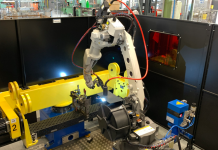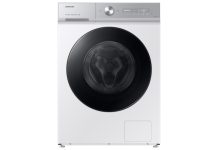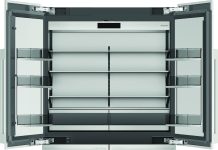A travel among touchscreens, pushbuttons, dials and knobs to identify what are the strong points and the critical elements of the different solutions.
Vivien Reimbelli and Valentina Zambello
 The performances of modern household appliances can be summarized in intrinsic performances and facilitation in their use. We can define the first as improved performances in the power/consumption ratio and in the feasibility of actions that were impossible before (or improved in the performance precision) but also as accessory functions like easier cleanliness or less occupation of space, once ended their use. The use simplification is the result of the application of electronic components that allow simplifying actions by increasingly turning to automatic functions that analyse all the operational aspects of the so called FAQ providing user-friendly “plug and play” solutions.
The performances of modern household appliances can be summarized in intrinsic performances and facilitation in their use. We can define the first as improved performances in the power/consumption ratio and in the feasibility of actions that were impossible before (or improved in the performance precision) but also as accessory functions like easier cleanliness or less occupation of space, once ended their use. The use simplification is the result of the application of electronic components that allow simplifying actions by increasingly turning to automatic functions that analyse all the operational aspects of the so called FAQ providing user-friendly “plug and play” solutions.
So far so good, except that there is always that element of connection between man and machine that can frustrate what excellently done in design phase in terms of performances. Lovers of speed perfectly know that the effort made over the last few years has increasingly pursued a better man-machine interface where the high performances concede very short response times and require precision, user-friendliness and response promptness to controls.
Without having the pretension to compare a mixer to a Formula One car, we can anyway analyse the effective correspondence between what is provided for in engineering terms and the practical use of appliances.
Among fires and flames
 Cooking appliances have lived great changes in the technology used, first of all induction cooking hobs, and consequently also the suitable controls for using them have been upgraded. The appearance of touch controls has certainly satisfied the lovers of minimalist aesthetics and of clean lines and also those who take care of cleaning in more canonical manner, but it does not always coincide with equal user friendliness. It often happens that the controls at issue have really minimalist sizes, with backlighting not always able to facilitate their reading. We should always consider that all reflecting surfaces are subjected to the imponderable alchemy of plays of light that in the kitchen are generated by the numerous lighting sources (room light, suction hood lights, spotlights against the false ceiling, etc.) that often interfere one another creating reflexes overlapping the lighting of touch screens. Among all, the most vexed are the oven screens that, due to their vertical position, act as real reflecting mirrors, to the extent of being totally unreadable.
Cooking appliances have lived great changes in the technology used, first of all induction cooking hobs, and consequently also the suitable controls for using them have been upgraded. The appearance of touch controls has certainly satisfied the lovers of minimalist aesthetics and of clean lines and also those who take care of cleaning in more canonical manner, but it does not always coincide with equal user friendliness. It often happens that the controls at issue have really minimalist sizes, with backlighting not always able to facilitate their reading. We should always consider that all reflecting surfaces are subjected to the imponderable alchemy of plays of light that in the kitchen are generated by the numerous lighting sources (room light, suction hood lights, spotlights against the false ceiling, etc.) that often interfere one another creating reflexes overlapping the lighting of touch screens. Among all, the most vexed are the oven screens that, due to their vertical position, act as real reflecting mirrors, to the extent of being totally unreadable.
Concerning this, the possibility of having tilting screens, adjustable by light intensity, can be of certain interest to bypass the problem connected with the different heights of operators, wherever a taller operator against a vertical display will see very little as the distance eye/screen will easily exceed the tilting threshold beyond which the screen will be unreadable. An interesting idea can be the modern LCD screens of cameras that are often adjustable on 2 inclination angles and, like the tablet screens, are provided with sensors able to regulate the lighting intensity according to the environmental light, making the reading possible in whatever light conditions.
certain interest to bypass the problem connected with the different heights of operators, wherever a taller operator against a vertical display will see very little as the distance eye/screen will easily exceed the tilting threshold beyond which the screen will be unreadable. An interesting idea can be the modern LCD screens of cameras that are often adjustable on 2 inclination angles and, like the tablet screens, are provided with sensors able to regulate the lighting intensity according to the environmental light, making the reading possible in whatever light conditions.
About menus
 Element of mortification of the even excellent applied technology is the use of complex menus that start moving us away from the concept of “user friendly” up to arriving at what in the USA has been defined the “fusion-confusion” of information. Concerning this, we remind the example of an appliance that needed a good 5 steps to activate a function:
Element of mortification of the even excellent applied technology is the use of complex menus that start moving us away from the concept of “user friendly” up to arriving at what in the USA has been defined the “fusion-confusion” of information. Concerning this, we remind the example of an appliance that needed a good 5 steps to activate a function:
1 Search of the main functions
2 Search of the chosen function
3 Selection of the function
4 Pressure of a separate “Ok” key to confirm the selection
5 Pressure of the “Start” key to start the function
The result was often that at step N°4 the user was convinced that he had started the machine and he discovered shortly after that it was instead still in standby, waiting for the definitive ok. Result: guests arriving and dinner still to cook.
The philosophies of development of appliance menus are essentially 2: the solution that provides for few controls with detailed menus and the solution with a main menu and a range of pushbuttons dedicated to the main functions.
The first solution certainly awards the essentiality of shapes and, being menus a range of rewritable files, it allows upgrading the machine without intervening on the hardware but more simply acting on the software, solving eventual “bugs” or perhaps improving their performances with more updated algorithms. This setting however provides that we enter the menus and submenus to reach the desired function and it will be necessary to understand well the course to be done, otherwise we will not find what we are looking for. Also the use of very clear and understandable inscriptions will aid the machine usability, especially in the case of drop-down menus that, when the used technology allows it, should clearly indicate the selected function with highlighted backgrounds or other.
machine without intervening on the hardware but more simply acting on the software, solving eventual “bugs” or perhaps improving their performances with more updated algorithms. This setting however provides that we enter the menus and submenus to reach the desired function and it will be necessary to understand well the course to be done, otherwise we will not find what we are looking for. Also the use of very clear and understandable inscriptions will aid the machine usability, especially in the case of drop-down menus that, when the used technology allows it, should clearly indicate the selected function with highlighted backgrounds or other.
The choice to take the path of dedicated controls can be seen as particularly suitable for those appliances that are intended for a dynamic use, with sudden shifts from one function to another that do not leave enough time to explore extensive menus. Certainly, the aesthetics will be strongly influenced but the possibility of entering with immediacy the main functions especially favours the appliances intended for a frequent use. Surprisingly, few touch screens are realized with this approach, that’s to say composed by a virtual keyboard where pushbuttons benefit from the absence of a physical key but conform to the logic of the ”exploded menu”.
In a certain period small dedicated keyboards proliferated: it seemed that a calculator had been glued to each appliance! It is certain that with the present possibilities in terms of material forming it might be possible to revisit the concept of a control panel  hidden by a retractable flap actuated by pressure: outdated? Maybe, but how the cousins across the Alps state, every now and then the Nouvelle Vieille is welcomed.
hidden by a retractable flap actuated by pressure: outdated? Maybe, but how the cousins across the Alps state, every now and then the Nouvelle Vieille is welcomed.
Another important remark concerns the excessive use of Anglo-Saxon terms in inscriptions: it’s true, we all do that, but in the inscriptions of the appliances we must pursue easy reading and immediacy and always consider that we are a Country with scarce linguistic vocation. In a nutshell, it means to avoid writings like SHOT or ANTIDRIP on an iron addressed to the Italian market, otherwise you will incur the wraths of ironing queens, notoriously not very young.
No sooner said than done
 In the daily use of appliances one of the most felt needs is the immediate response by controls. Just imagine you are struggling with multiple firings at the same time and you are not sure you have lowered the heat in time, thus witnessing the inexorable carbonization of onions and herbs lightly fried in oil for a risotto because the control did not respond in real time or because we did not succeed in regulating it as we thought. It may seem strange but there are lots of consumers, especially those not in the very first coat, who find controls of this kind uncomfortable and perhaps it might be one of the reasons for which lots of them still turn to the old dear gas stove.
In the daily use of appliances one of the most felt needs is the immediate response by controls. Just imagine you are struggling with multiple firings at the same time and you are not sure you have lowered the heat in time, thus witnessing the inexorable carbonization of onions and herbs lightly fried in oil for a risotto because the control did not respond in real time or because we did not succeed in regulating it as we thought. It may seem strange but there are lots of consumers, especially those not in the very first coat, who find controls of this kind uncomfortable and perhaps it might be one of the reasons for which lots of them still turn to the old dear gas stove.
Another element worth considering is the not perfect cleaning of the control surface during the practical use, where they might form slight patina caused by seasonings that have the very bad habit to escape while cooking (yes, in spite of all this technology, pans still squirt!) thus interfering with the dielectric capacity of the control and actually blocking its functions.
all this technology, pans still squirt!) thus interfering with the dielectric capacity of the control and actually blocking its functions.
But what happened to old knobs? Certainly we must come to terms with the market and we perfectly know  that modern design does not look kindly on controls that have an obvious retro-looking, but perhaps we should modernize them in shapes and materials. Concerning this, the upgrading should be not only aesthetic, as it more and more often happens to see in small appliances that recently make growing use of small-size knobs made with excellent and bright polished stainless steel, may be a bit hard to turn: have you ever tried to use a mixer or a blender while you are cooking and lived the joy
that modern design does not look kindly on controls that have an obvious retro-looking, but perhaps we should modernize them in shapes and materials. Concerning this, the upgrading should be not only aesthetic, as it more and more often happens to see in small appliances that recently make growing use of small-size knobs made with excellent and bright polished stainless steel, may be a bit hard to turn: have you ever tried to use a mixer or a blender while you are cooking and lived the joy of an “aquaplaning” effect while you are trying to reduce the appliance speed? Goodbye mayonnaise.
of an “aquaplaning” effect while you are trying to reduce the appliance speed? Goodbye mayonnaise.
Just to make an example, in yachting, operating environment strongly conditioned by saltiness, with often slippery surfaces, the choice of controls has always been oriented to remarkable sizes and coatings that facilitate a good grip.
Within reach
 Obviously, all that that is true also for cleaning appliances. A vacuum cleaner is expected to have easily usable controls, especially when we are bent and perhaps with a carpet lifted by our free hand in the attempt of reducing the growth of an unlikely coral reef in the remote corners of the house. “Foot” controls are adequate but they require a balance not always within the reach of not very young people and not all are able to maintain combat postures in Matrix style.
Obviously, all that that is true also for cleaning appliances. A vacuum cleaner is expected to have easily usable controls, especially when we are bent and perhaps with a carpet lifted by our free hand in the attempt of reducing the growth of an unlikely coral reef in the remote corners of the house. “Foot” controls are adequate but they require a balance not always within the reach of not very young people and not all are able to maintain combat postures in Matrix style.
It would be opportune to have the controls always next to the handle, actually like in electric brooms. Also in this case a user-friendly lever control or an oversized control will facilitate the appliance use.
The general ergonomics of controls should take into account the use for which appliances are intended, trying to always immerse ourselves into the real operation conditions in which they will function, considering all environmental factors that will influence their ease of use like wet or not perfectly clean hands, narrow spaces, non ideal lighting, operator’s impaired vision etc. We can find an interesting cue in the modern aviation world, with the so called HOTAS controls, acronym of Hands On Trottel and Stick, that’s to say a philosophy that groups the main functions on 2 controls, one for each hand, reducing the need of wandering around with your fingers in search of pushbuttons and similar. As completion of the system a HUD, that’s to say Head Up Display, is used, actually a screen with a holographic projection of flight parameters. Futuristic? Maybe, but some time ago a French car company had introduced it on its cars, instead the standard dashboard. Advantages? Comparable to the mouse advent for computers.
trying to always immerse ourselves into the real operation conditions in which they will function, considering all environmental factors that will influence their ease of use like wet or not perfectly clean hands, narrow spaces, non ideal lighting, operator’s impaired vision etc. We can find an interesting cue in the modern aviation world, with the so called HOTAS controls, acronym of Hands On Trottel and Stick, that’s to say a philosophy that groups the main functions on 2 controls, one for each hand, reducing the need of wandering around with your fingers in search of pushbuttons and similar. As completion of the system a HUD, that’s to say Head Up Display, is used, actually a screen with a holographic projection of flight parameters. Futuristic? Maybe, but some time ago a French car company had introduced it on its cars, instead the standard dashboard. Advantages? Comparable to the mouse advent for computers.




